Mathea Ford's Blog, page 4
April 2, 2025
How can I safely flavor my meals using herbs, spices, or salt substitutes?-Podcast
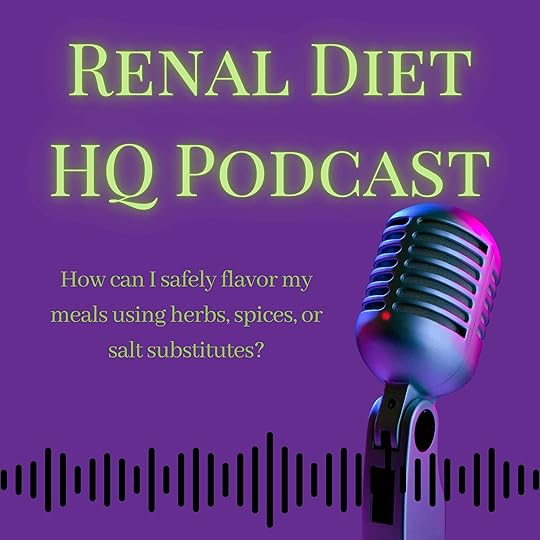
If you have Chronic Kidney Disease (CKD), you might be looking for ways to add delicious flavor to your meals without relying on salt. The good news? There are plenty of herbs and spices that can enhance your food while supporting kidney health.
In this guide, weâll explore kidney-friendly herbs, spices, and salt alternatives to help you enjoy flavorful, healthy meals without compromising your well-being.
For More Recipes and Ideas --->> Get Your Free Meals and Recipes That Are Perfect for Pre-Dialysis Diets, Pre-Dialysis with Diabetes, or Dialysis Diets.
Why Avoid Excess Salt?For people with CKD, managing sodium intake is crucial. High sodium levels can:
â Raise blood pressure
â Increase fluid retention
â Worsen kidney function
Since the kidneys have difficulty filtering out excess sodium, reducing salt in your diet can help protect your kidney health. But donât worryâyou donât have to eat bland food! Herbs, spices, and other natural flavor boosters can keep your meals tasty and satisfying.
Choosing Kidney-Friendly Herbs & SpicesMany fresh and dried herbs and spices are naturally low in sodium, potassium, and phosphorus, making them a great choice for a CKD-friendly diet.
Here are some of the best kidney-friendly seasonings:
â Best Herbs for CKD:Basil â Adds freshness to salads, pasta, and chicken.Oregano â Perfect for Italian and Mediterranean dishes.Rosemary â Great for roasting meats and vegetables.Thyme â Ideal for soups, stews, and poultry dishes.Parsley â A fresh, mild herb that enhances many dishes.â Best Spices for CKD:Black pepper â A classic seasoning for all meals.Turmeric â Anti-inflammatory and great for rice, soups, and curries.Garlic powder â Adds depth without excess sodium.Paprika â A smoky, slightly sweet spice for meats and veggies.Cinnamon â Perfect for oatmeal, desserts, and even savory dishes.How to Use Herbs & Spices for Maximum FlavorUsing herbs and spices the right way can make a big difference in your cooking. Here are some simple flavor-boosting tips:
ð§âð³ Pairing Herbs & Spices with FoodsFor poultry & fish: Use rosemary, thyme, lemon zest.For vegetables: Add garlic powder, cumin, smoked paprika.For soups & stews: Try bay leaves, black pepper, oregano.ð¿ Create Your Own Seasoning BlendsInstead of buying store-bought seasoning mixes (which often contain added sodium), try making your own!
ð DIY Herb Blend: Mix dried basil, oregano, and thyme for a flavorful all-purpose seasoning.
ð Savory Spice Blend: Combine garlic powder, onion powder, black pepper, and paprika.
Many commercial salt substitutes contain potassium chloride, which may not be safe for people with CKD. High potassium levels can be dangerous if your kidneys canât properly filter them.
ð« What to Avoid:Potassium chloride-based salt substitutes (often labeled as "low-sodium salt")MSG (monosodium glutamate)â Kidney-Friendly Alternatives:Lemon juice & zest â Adds brightness to any dish.Vinegar (apple cider, balsamic, red wine) â Enhances depth and acidity.Nutritional yeast â Provides a cheesy, umami flavor.Simple Flavor-Boosting Cooking TechniquesCooking techniques can naturally enhance flavors without adding salt. Here are some easy ways to make your food taste amazing:
ð¥ Roasting: Brings out the natural sweetness of vegetables.
ð¥ Sautéing: Using olive oil and garlic adds depth to dishes.
𥩠Grilling: Creates a smoky, savory flavor.
ð¥ Marinating: Herbs, citrus, and vinegar can infuse meats and vegetables with bold flavors.
Eating with Chronic Kidney Disease doesnât mean giving up on delicious, flavorful meals. By using herbs, spices, and natural flavor boosters, you can create exciting dishes while keeping your kidneys healthy.
Start experimenting today with kidney-friendly seasonings, cooking techniques, and salt alternatives!
ð¬ Whatâs your favorite herb or spice to cook with? Share your thoughts in the comments!
Learn more about Apple Cider Vinegar and CKD: Is It Safe for Your Kidneys?-Podcast
The post How can I safely flavor my meals using herbs, spices, or salt substitutes?-Podcast appeared first on Renal Diet HQ.
March 28, 2025
Apple Cider Vinegar and CKD: Is It Safe for Your Kidneys?-Podcast

Are you looking for a natural way to support your kidney health? Apple cider vinegar (ACV), a centuries-old folk remedy, may offer surprising benefits for individuals with chronic kidney disease (CKD). Known for aiding digestion, reducing inflammation, and managing cholesterol, ACV is also being studied for its potential role in improving kidney function. In this post, weâll explore how ACV may impact kidney health, what research says, and how to use it safely.
For More Recipes and Ideas --->> Get Your Free Meals and Recipes That Are Perfect for Pre-Dialysis Diets, Pre-Dialysis with Diabetes, or Dialysis Diets.
What is Apple Cider Vinegar?Apple cider vinegar is a fermented liquid made from crushed apples, yeast, and bacteria. This process creates acetic acid, which is believed to be responsible for many of its health benefits. Traditionally, ACV has been used for a variety of purposes, including digestion support, weight management, and immune system enhancement.
Potential Benefits of Apple Cider Vinegar for Kidney Health1. Aiding DigestionACV has long been used to support gut health. The acetic acid in ACV may help improve digestion by promoting the production of digestive enzymes. A healthy gut is essential for overall well-being, including kidney function, as it helps regulate nutrient absorption and waste elimination.
2. Reducing InflammationChronic inflammation is a common concern for individuals with CKD. ACV contains antioxidants and compounds that may help lower inflammation levels. By reducing inflammation, ACV could potentially ease some of the strain on the kidneys and support better function.
3. Managing CholesterolThere is evidence that ACV may help manage cholesterol levels, which is important for kidney health. High cholesterol can contribute to cardiovascular issues, which are common in CKD patients. Some studies suggest that ACV can help lower LDL (bad) cholesterol while increasing HDL (good) cholesterol.
4. Improving Kidney FunctionWhile research is still ongoing, early studies indicate that small, regular doses of ACV may help support kidney function. Some theories suggest that ACVâs alkalizing effect may help balance the bodyâs pH levels, reducing strain on the kidneys.
Scientific Evidence and Ongoing ResearchWhile many people use ACV as a home remedy, scientific research is still in its early stages. Some animal studies have shown promising results, but more human trials are needed to confirm its effectiveness for kidney health. Experts recommend using ACV as a complementary approach rather than a sole treatment.
How to Incorporate Apple Cider Vinegar SafelyIf you are considering adding ACV to your diet, here are some important guidelines:
Recommended Dosage: Start with small amounts, such as one teaspoon diluted in water per day, and gradually increase if tolerated.Best Ways to Consume: Mix ACV with water, add it to salad dressings, or use it in cooking.Potential Risks: ACV is acidic and can erode tooth enamel if consumed undiluted. It may also interact with medications, so itâs important to consult your doctor before using it regularly.Apple cider vinegar is a popular natural remedy with potential benefits for digestion, inflammation, and cholesterol managementâall of which can impact kidney health. While early research is promising, more studies are needed to confirm its effectiveness for CKD patients. If youâre interested in trying ACV, be sure to use it in moderation and consult your healthcare provider to ensure it aligns with your health needs.
By staying informed and making thoughtful dietary choices, you can take proactive steps toward better kidney health. Have you tried ACV for kidney support? Share your experience in the comments below!
Lear more about What role does a renal dietitian play and how can they help with managing CKD?-Podcast
The post Apple Cider Vinegar and CKD: Is It Safe for Your Kidneys?-Podcast appeared first on Renal Diet HQ.
March 26, 2025
What role does a Renal Dietitian play and how can they help with managing CKD?-Podcast
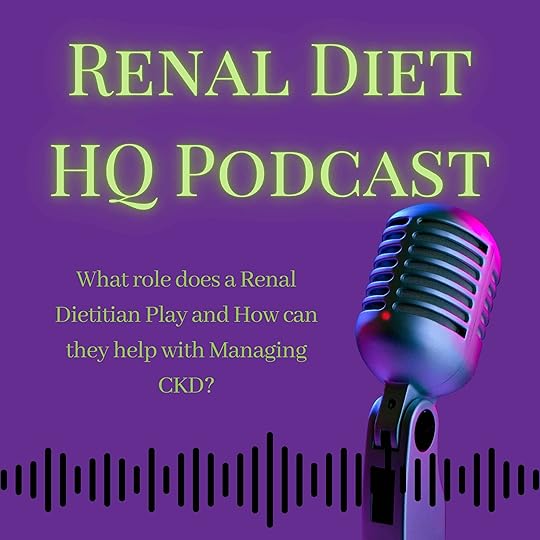
Chronic Kidney Disease (CKD) is a serious condition that affects millions of people worldwide. Managing CKD requires a comprehensive approach, with nutrition playing a crucial role in slowing its progression and maintaining overall health. However, understanding which foods to eat and which to avoid can be overwhelming. Thatâs where a renal dietitian comes in.
For More Recipes and Ideas --->> Get Your Free Meals and Recipes That Are Perfect for Pre-Dialysis Diets, Pre-Dialysis with Diabetes, or Dialysis Diets.
A renal dietitian specializes in kidney health and works closely with CKD patients to create personalized nutrition plans that support kidney function. In this blog post, weâll explore the essential role a renal dietitian plays in managing CKD and why consulting one could be a game-changer for your health.
What is a Renal Dietitian?A renal dietitian is a registered dietitian (RD) with specialized training in kidney-friendly nutrition. They help CKD patients navigate dietary restrictions and make informed food choices to support kidney function.
What Makes Them Different?Unlike general dietitians, renal dietitians focus specifically on:
Managing key nutrients like sodium, potassium, phosphorus, and protein.Helping CKD patients maintain optimal hydration without overloading their kidneys.Providing meal plans tailored to each patientâs CKD stage and overall health.By working with a renal dietitian, patients gain a better understanding of how diet directly impacts kidney function and how they can make sustainable changes to improve their health.
How Can a Renal Dietitian Help?1. Personalized Nutrition GuidanceEvery CKD patient is unique, and a one-size-fits-all approach to diet simply doesnât work. A renal dietitian evaluates:
Your CKD stage and lab resultsYour lifestyle and food preferencesYour other health conditions, such as diabetes or high blood pressureUsing this information, they create a customized meal plan that fits your needs while still allowing you to enjoy food.
2. Balancing Key NutrientsManaging CKD requires careful monitoring of sodium, potassium, phosphorus, and protein intake. A renal dietitian helps you understand:
Why too much sodium can lead to high blood pressure and fluid retentionHow potassium levels affect heart health and kidney functionWhich phosphorus-rich foods to avoid to protect bone healthHow to get enough protein without overloading your kidneysBy keeping these nutrients in check, patients can slow CKD progression and reduce symptoms like swelling and fatigue.
3. Making Food EnjoyableOne of the biggest concerns for CKD patients is the fear of giving up favorite foods. The good news? You donât have to! A renal dietitian helps you:
Find kidney-friendly alternatives to high-sodium and high-potassium foods.Modify recipes to make them CKD-friendly while keeping flavors intact.Discover new, delicious meals that fit within your dietary restrictions.For more CKD-friendly recipes, check out RenalDietHQ.com! ð²
4. Understanding Food LabelsReading nutrition labels can be tricky, especially when ingredients like hidden sodium, phosphorus, and potassium are not always obvious. A renal dietitian teaches you:
How to spot hidden additives that could harm your kidneys.What to look for in ingredient lists to make safer choices.Which food brands offer kidney-friendly options.By mastering food labels, youâll gain greater control over your diet and make healthier choices when shopping.
Supporting Overall Health Beyond CKDMany CKD patients also have other health conditions, such as:
Diabetes â Managing blood sugar levels is crucial for kidney health.High blood pressure â A low-sodium diet can help keep BP in check.Heart disease â A balanced CKD diet supports heart health too.A renal dietitian helps create a plan that addresses all of these conditions, ensuring you stay as healthy as possible while managing CKD.
When Should You See a Renal Dietitian?The sooner, the better! Whether youâve just been diagnosed or are already on dialysis, a renal dietitian can help you:
â
Slow disease progression by managing your diet early.
â
Avoid common dietary mistakes that worsen kidney function.
â
Stay motivated and on track with a structured eating plan.
If you have CKD, ask your doctor for a referral to a renal dietitian. Your kidneys will thank you!
A renal dietitian isnât just someone who tells you what to eatâtheyâre a vital partner in your CKD journey. By working with one, you can take control of your diet, protect your kidneys, and improve your quality of life.
Have you worked with a renal dietitian before? Share your experience in the comments! ð¬
#KidneyHealth #RenalDietitian #CKDManagement #HealthyEating
Learn more about Top Lunch Ideas for a Renal Diet Delicious KidneyFriendly Meals
The post What role does a Renal Dietitian play and how can they help with managing CKD?-Podcast appeared first on Renal Diet HQ.
March 21, 2025
Top Lunch Ideas for a Renal Diet Delicious Kidney Friendly Meals-Podcast

Living with Chronic Kidney Disease (CKD) requires careful attention to diet. The foods you eat can either help slow the progression of kidney disease or put extra strain on your kidneys. By making kidney-friendly food choices, you can better manage CKD and maintain your overall health.
In this blog post, weâll explore the best foods to eat and which to avoid when following a kidney-safe diet. Weâll also provide practical meal-planning tips to help you stay on track.
For More Recipes and Ideas --->> Get Your Free Meals and Recipes That Are Perfect for Pre-Dialysis Diets, Pre-Dialysis with Diabetes, or Dialysis Diets.
Understanding CKD and NutritionYour kidneys play a crucial role in filtering waste, balancing minerals, and regulating fluids in your body. When CKD progresses, the kidneys lose their ability to perform these functions efficiently. This means that what you eat directly impacts your kidney health.
The key dietary factors to watch include:
Sodium â Too much sodium can cause high blood pressure and fluid retention.Phosphorus â Excess phosphorus can weaken bones and harm the heart.Potassium â High potassium levels can lead to dangerous heart complications.Protein â Too much protein increases kidney workload, but some protein is still essential.By managing these nutrients, you can help reduce kidney stress and support overall well-being.
Foods to Include in a Kidney-Friendly DietWhile CKD requires dietary restrictions, there are still plenty of delicious and nutritious foods you can enjoy. Here are some kidney-safe choices:
Low-Sodium Choices:Fresh fruits and vegetables (apples, berries, cauliflower, cucumbers, and zucchini)Herbs and spices instead of salt for flavor (garlic, rosemary, thyme)Fresh or frozen lean meats (chicken, turkey, fish) rather than processed meatsLow-Phosphorus Options:White rice instead of brown riceCauliflower as an alternative to potatoesEgg whites instead of whole eggsControlled-Potassium Foods:Apples, berries, and grapes instead of bananas and orangesGreen beans and cabbage instead of potatoes or tomatoesLean Protein Sources:Skinless poultry and fishSmall portions of tofu or plant-based proteinsEgg whitesThese foods provide essential nutrients while minimizing stress on your kidneys.
Foods to Avoid or LimitSome foods contain high amounts of sodium, phosphorus, and potassium, which can negatively affect kidney function. Here are the foods you should limit or avoid:
High-Sodium Foods:Processed meats (bacon, sausage, deli meats)Canned soups and frozen meals with added saltFast food and salty snacks like chips and pretzelsHigh-Phosphorus Foods:Dairy products (milk, cheese, yogurt)Nuts, seeds, and whole grainsDark sodas and processed foods with phosphorus additivesHigh-Potassium Foods:Bananas, oranges, and melonsPotatoes, tomatoes, and avocadosBeans and lentilsExcessive Protein Intake:While protein is necessary, eating too much can strain the kidneys. Choose moderate portions of lean meats, fish, and eggs.Smart Meal Planning TipsMaking kidney-friendly meals doesnât have to be difficult. Here are some simple tips to make meal planning easier:
â Read Food Labels: Look for hidden sources of sodium and phosphorus in packaged foods. â Cook at Home: Preparing your own meals allows you to control ingredients and avoid excess salt.
â Use Flavorful Alternatives: Try herbs, lemon juice, and garlic instead of salt.
â Manage Portions: Eating smaller portions can help balance nutrient intake.
â Stay Hydrated: Drinking enough water (within your doctorâs recommendations) supports kidney function.
By following these tips, you can enjoy tasty meals without compromising your kidney health.
Lifestyle and Dietary Adjustments for CKDManaging CKD isnât just about avoiding certain foodsâitâs about making sustainable lifestyle changes. Here are some important adjustments to consider:
Work with a dietitian to create a meal plan that suits your specific needs.Track your food intake to monitor sodium, phosphorus, and potassium levels.Make gradual changes rather than drastic dietary shifts.Stay consistent and motivatedâsmall changes can have a big impact!Eating a kidney-safe diet is one of the best ways to manage CKD and support your overall health. By choosing the right foods, limiting harmful nutrients, and planning meals wisely, you can take control of your kidney health and feel better every day.
Remember, your diet plays a crucial role in your quality of life with CKD. Making thoughtful food choices now can slow disease progression and improve your well-being.
ð Need more guidance? Visit RenalDietHQ.com for more resources on kidney-friendly eating!
Learn more about How Do Phosphate Binders Help Control Phosphorus Levels in CKD?-Podcast
The post Top Lunch Ideas for a Renal Diet Delicious Kidney Friendly Meals-Podcast appeared first on Renal Diet HQ.
March 19, 2025
How Do Phosphate Binders Help Control Phosphorus Levels in CKD?-Podcast

Managing chronic kidney disease (CKD) involves many dietary adjustments, and one critical aspect is controlling phosphorus levels. High phosphorus levels can be harmful to people with CKD, leading to complications such as bone and heart problems. This is where phosphate binders come in. In this blog post, weâll explore what phosphate binders are, how they work, and why they are essential for kidney health.
For More Recipes and Ideas --->> Get Your Free Meals and Recipes That Are Perfect for Pre-Dialysis Diets, Pre-Dialysis with Diabetes, or Dialysis Diets.
Why Phosphorus Matters in CKDPhosphorus is a mineral that plays a vital role in bone health, energy production, and cell function. However, when kidney function declines, the body struggles to remove excess phosphorus. Too much phosphorus in the blood can lead to issues like:
Weakened bonesIncreased risk of heart diseaseCalcification (hardening) of tissues and blood vesselsFor CKD patients, managing phosphorus levels is crucial to preventing these complications.
What Are Phosphate Binders?Phosphate binders are medications that help control phosphorus levels in people with CKD. They work by binding to phosphorus in food before it gets absorbed into the bloodstream. Instead of being absorbed, the phosphorus passes through the digestive system and is excreted in stool. This helps prevent dangerous phosphorus buildup in the body.
Types of Phosphate BindersThere are different types of phosphate binders available, each with its own benefits and considerations:
Calcium-based binders â These include calcium acetate and calcium carbonate. They help bind phosphorus while also providing calcium, but excessive calcium intake can lead to calcification in blood vessels.Non-calcium-based binders â These include sevelamer, lanthanum, and ferric citrate. They do not contain calcium, making them a preferred option for those at risk of high calcium levels.Aluminum-based binders â These were commonly used in the past but are now less recommended due to the risk of aluminum toxicity.Your healthcare provider will recommend the best phosphate binder for you based on your specific needs.
How to Take Phosphate Binders EffectivelyFor phosphate binders to work properly, they must be taken correctly. Here are some key guidelines:
Take them with meals â Phosphate binders only work when food is present to bind with.Follow the prescribed dosage â Taking too little or too much can be ineffective or harmful.Avoid skipping doses â Inconsistent use can lead to uncontrolled phosphorus levels.Discuss with your doctor â If you experience side effects or difficulty taking them, consult your healthcare provider for adjustments.Side Effects and ConsiderationsLike any medication, phosphate binders can have side effects. Common ones include:
NauseaConstipation or diarrheaUpset stomachHigh calcium levels (for calcium-based binders)Itâs important to monitor your response to these medications and report any concerns to your healthcare provider. Regular blood tests will help ensure phosphorus levels remain within a safe range.
Phosphorus control is a key part of managing CKD, and phosphate binders play an essential role in this process. By understanding how they work and using them correctly, you can help protect your bones, heart, and overall health. Always follow your doctorâs guidance and stay proactive about managing your kidney health.
If you found this article helpful, consider sharing it with others who may benefit from understanding phosphate binders and their role in CKD management!
Learn more about Renal Vegetarian Diet: Kidney-Friendly Meals for CKD-Podcast
The post How Do Phosphate Binders Help Control Phosphorus Levels in CKD?-Podcast appeared first on Renal Diet HQ.
March 17, 2025
Renal Vegetarian Diet: Kidney-Friendly Meals for CKD-Podcast

Following a vegetarian diet while managing kidney disease can feel overwhelming, but it doesnât have to be. With the right approach, a well-balanced plant-based diet can be both enjoyable and beneficial for kidney health. This guide will provide practical tips and insights to help you navigate a renal-friendly vegetarian diet while ensuring you get the nutrients your body needs.
For More Recipes and Ideas --->> Get Your Free Meals and Recipes That Are Perfect for Pre-Dialysis Diets, Pre-Dialysis with Diabetes, or Dialysis Diets.
Why Consider a Kidney-Friendly Vegetarian Diet?A plant-based diet offers numerous health benefits, especially for those with kidney disease. Some of the key advantages include:
Lowering cholesterol levels: Reducing animal-based proteins can help manage cholesterol, benefiting heart and kidney health.Reducing inflammation: A diet rich in fruits, vegetables, and antioxidants can decrease inflammation in the body.Boosting overall health: Nutrient-dense foods provide essential vitamins, minerals, and fiber, all of which support kidney function and general well-being.By increasing your intake of plant-based foods while being mindful of potassium, phosphorus, and protein, you can create a diet that supports both kidney health and overall wellness.
Key Considerations for a Renal Vegetarian DietTo maintain a balanced kidney-friendly vegetarian diet, itâs important to focus on nutrient management and protein sources.
Protein SourcesGetting enough protein while avoiding excessive potassium and phosphorus can be challenging. Consider these kidney-friendly plant-based protein options:
Tofu and tempeh (in moderation)Lentils and beans (portion-controlled)Quinoa and whole grains for added protein and fiberBalancing NutrientsWhile plant-based foods are packed with nutrients, itâs important to keep an eye on sodium, potassium, and phosphorus levels. Some tips include:
Choosing low-potassium vegetables like bell peppers, cabbage, and zucchini.Avoiding high-phosphorus additives in processed foods.Using herbs and spices instead of salt to enhance flavor.Portion Control and Smart Food ChoicesPortion sizes play a crucial role in managing nutrient intake. Even healthy foods can be harmful if consumed in excess. Stick to recommended serving sizes to avoid excess potassium and phosphorus.
Tips for Success on a Renal Vegetarian DietMaking the switch to a kidney-friendly vegetarian diet is easier with these practical tips:
Meal Planning StrategiesPlan meals ahead using low-sodium, kidney-friendly ingredients.Include a variety of plant-based proteins to meet your nutritional needs.Experiment with kidney-friendly seasoning like garlic, lemon, and fresh herbs.Reading LabelsCheck for hidden phosphorus and sodium additives in packaged foods.Opt for fresh, whole foods whenever possible.Consulting with a DietitianEvery personâs dietary needs are unique. A registered dietitian can help create a customized plan to ensure you get the right balance of nutrients while protecting kidney function.
Transitioning to a kidney-friendly vegetarian diet doesnât have to be difficult. With careful planning, mindful food choices, and portion control, you can enjoy a nutrient-rich plant-based diet while managing your kidney health. Start small, make gradual changes, and consult a healthcare professional for personalized guidance. Your journey to better kidney health begins with informed choices and a balanced diet.
Looking for more guidance? Check out additional resources on kidney-friendly nutrition to support your health journey!
Learn more about Kidney Disease and Fast Food: Safe Options You Can Enjoy-Podcast
The post Renal Vegetarian Diet: Kidney-Friendly Meals for CKD-Podcast appeared first on Renal Diet HQ.
March 11, 2025
Spinach and Goat Cheese Chicken Breasts
Transform your dinner routine with this easy-to-follow recipe that combines flavor, nutrition, and kidney health for a satisfying meal
Are you looking for a kidney-friendly recipe that doesn't compromise on flavor? This Spinach and Goat Cheese Stuffed Chicken Breasts recipe is a delicious solution tailored to meet the dietary needs of individuals with kidney disease. By combining tender chicken with creamy goat cheese, crisp spinach, and a rich balsamic glaze, this dish not only satisfies your tastebuds but also aligns with your nutritional goals. With no need for excessive salt and a focus on wholesome ingredients, this recipe supports kidney health while transforming your dinner routine into a satisfying and nutritious experience.
As a Registered Dietitian with over 25 years of experience, and having both of my parents diagnosed with Chronic Kidney Disease (CKD), I understand the challenges of preparing meals that support kidney health without sacrificing flavor. By focusing on low-sodium, nutrient-rich ingredients and aligning with current dietary guidelines for CKD, this dish offers a practical and satisfying way to manage kidney health while enjoying a delicious meal.

This delightful recipe seamlessly integrates with a Chronic Kidney Disease (CKD) diet due to its mindful selection of ingredients that are both nutritious and gentle on the kidneys. The use of fresh spinach and goat cheese provides essential nutrients while maintaining lower levels of sodium, which is crucial for kidney health. Additionally, the flavorful balsamic glaze adds taste without overwhelming the dish with extra sodium or potassium, making it a thoughtful choice for those mindful of their kidney health.
This recipe is one of my very favorite as it combines goat cheese and spinach, both of which I love. You can serve this with a salad like our mandarin orange salad or one of our other kidney friendly salads. And enjoy it with our Tangerine cake or oatmeal date bars for a renal diet dessert!
This delightful combination brings together savory flavors and rich textures for a scrumptious, gourmet experience.
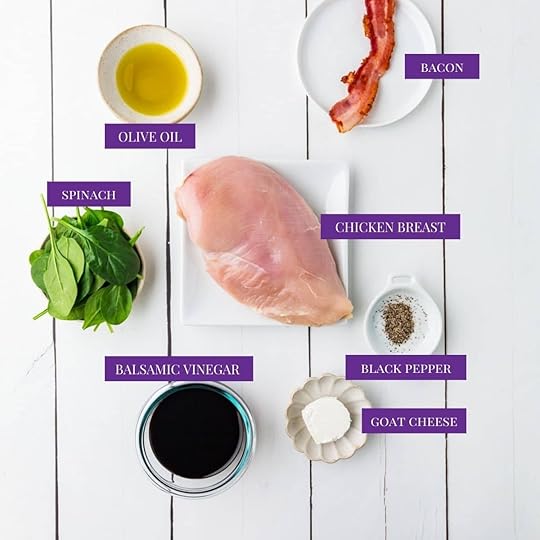 Olive Oil: This staple ingredient is perfect for both salads and cooking, providing a rich flavor and healthy fats that enhance the overall dish.Chicken Breast: A lean source of protein, chicken breast serves as the hearty base of the meal, offering a satisfying and nutritious component.Goat Cheese: Bringing a creamy texture and tangy flavor, goat cheese complements the other ingredients and adds a touch of indulgence.Bacon: Even with reduced salt, bacon offers a savory and smoky taste, contributing a delightful crispiness to the recipe.Fresh Spinach: This leafy green provides freshness, color, and a boost of nutrients, balancing the flavors of the dish beautifully.Black Pepper: Ground black pepper enhances the taste profile with a hint of spice, elevating the mealâs overall flavor.Balsamic Vinegar: A splash of balsamic vinegar adds a sweet and tangy note, tying the ingredients together with its vibrant and complex essence.
Olive Oil: This staple ingredient is perfect for both salads and cooking, providing a rich flavor and healthy fats that enhance the overall dish.Chicken Breast: A lean source of protein, chicken breast serves as the hearty base of the meal, offering a satisfying and nutritious component.Goat Cheese: Bringing a creamy texture and tangy flavor, goat cheese complements the other ingredients and adds a touch of indulgence.Bacon: Even with reduced salt, bacon offers a savory and smoky taste, contributing a delightful crispiness to the recipe.Fresh Spinach: This leafy green provides freshness, color, and a boost of nutrients, balancing the flavors of the dish beautifully.Black Pepper: Ground black pepper enhances the taste profile with a hint of spice, elevating the mealâs overall flavor.Balsamic Vinegar: A splash of balsamic vinegar adds a sweet and tangy note, tying the ingredients together with its vibrant and complex essence.See recipe card for quantities.
How to Make Spinach and Cheese Stuffed Chicken BreastsGet ready to impress with this flavorful dish! Low sodium spinach and goat cheese stuffed chicken breasts, drizzled with a balsamic glaze, combine creamy, savory, and tangy elements into a delightful main course.
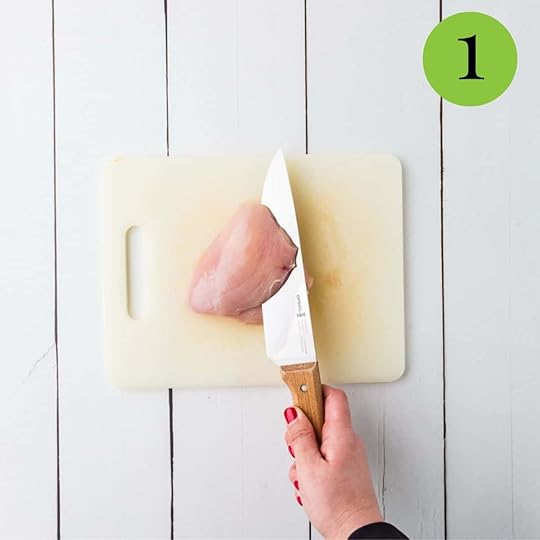 Preheat oven to 375 degrees.Butterfly the chicken by running a sharp knife horizontally through the thickest part of each breast. Place one hand on top of the breast to stabilize while holding the knife parallel to the work surface while cutting. Do not cut all the way through. Open the breast so both halves can lie flat.
Preheat oven to 375 degrees.Butterfly the chicken by running a sharp knife horizontally through the thickest part of each breast. Place one hand on top of the breast to stabilize while holding the knife parallel to the work surface while cutting. Do not cut all the way through. Open the breast so both halves can lie flat.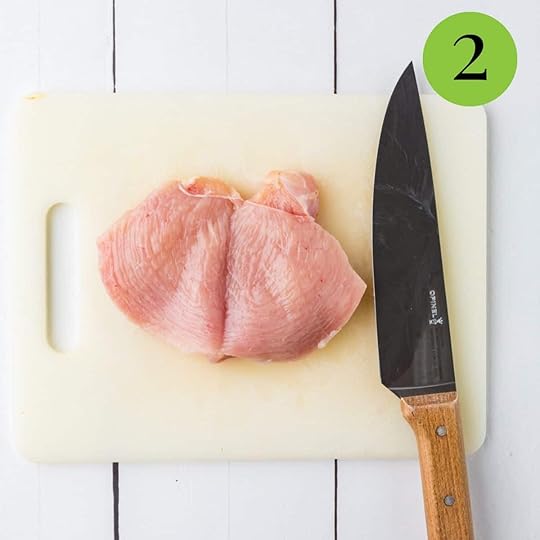
3. Season the exposed surface with pepper, then add ½ of the goat cheese, crumbled bacon, and spinach leaves to each breast. Fold the breasts in half so the cheese mixture is surrounded by chicken breast on the bottom, back and top. Secure with long wooden toothpicks, if desired.
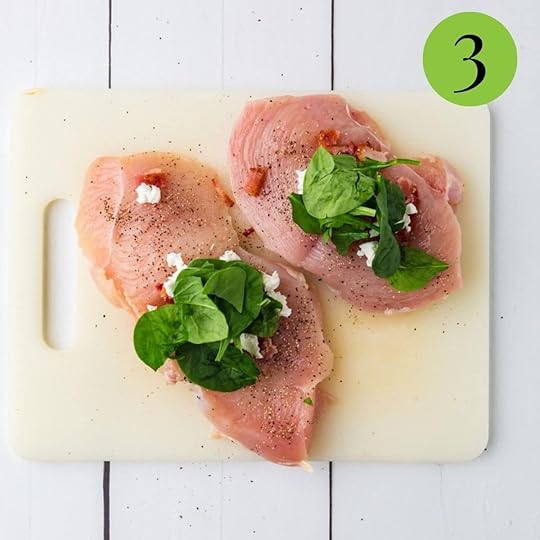
3. Season the exposed surface with pepper, then add ½ of the goat cheese, crumbled bacon, and spinach leaves to each breast. Fold the breasts in half so the cheese mixture is surrounded by chicken breast on the bottom, back and top. Secure with long wooden toothpicks, if desired.
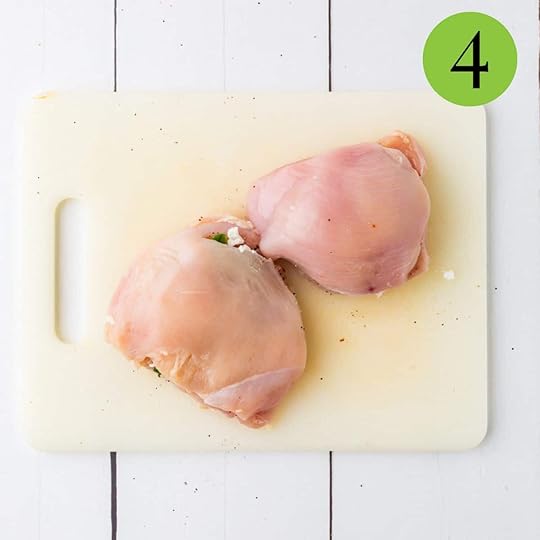
4. Heat olive oil over medium-high heat in a large oven-safe skillet. Once hot, add the stuffed chicken breasts to the pan to sear. Once browned on the bottom, carefully turn each breast over and repeat on the other side. Season top and bottom with pepper, if desired, during this process.
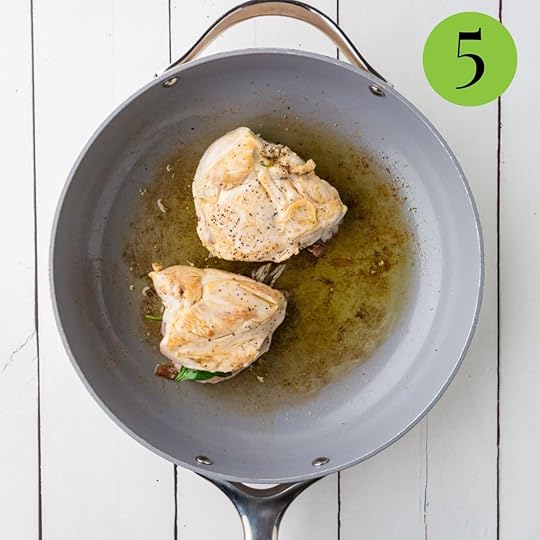
5. Place skillet in preheated oven and cook until an instant read thermometer reads 165 degrees Fahrenheit when inserted, approximately 25-30 minutes. Remove from the oven and cover until ready to serve.
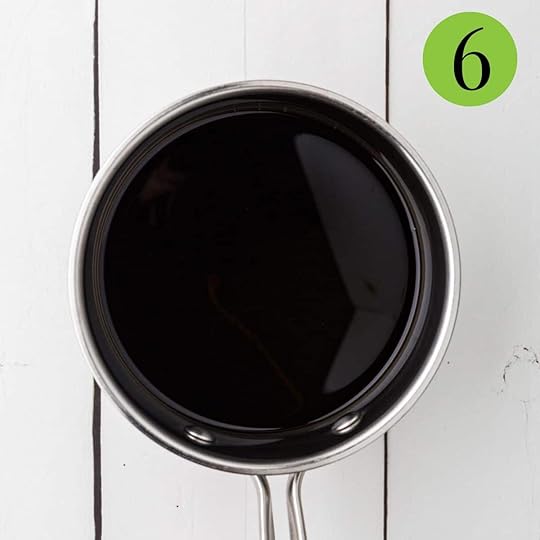
6. A few minutes before removing the chicken from the oven, start making the balsamic glaze. Heat balsamic vinegar in a small sauce pan over medium-high heat. Stir while heating until the vinegar is reduced to about â
of its original volume. It will form a thick, syrupy consistency when it is ready.
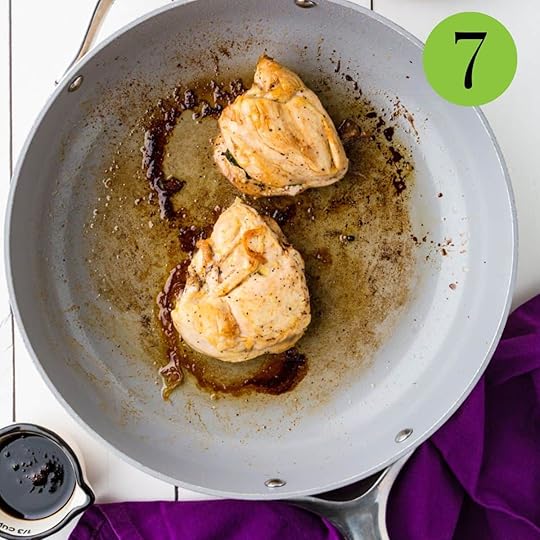
7. To serve, place a stuffed chicken breast on each plate and drizzle with balsamic glaze.

Perfectly done Spinach and Goat Cheese Chicken Breasts.
Hint: Prevent Cheese from Leaking: To ensure the cheese stays in the chicken during cooking, secure the edges well with toothpicks or kitchen twine. This will help keep the filling intact.
 Variations for Bacon and Spinach Stuffed Chicken
Variations for Bacon and Spinach Stuffed ChickenSpinach and Goat Cheese Stuffed Chicken Breasts offer a delightful combination of flavors that elevate a classic dish to new heights. This recipe balances the savory taste of chicken with the creamy texture of goat cheese and the freshness of spinach. Enjoy these kidney-friendly variations if you're managing your diet for chronic kidney disease.
Herb-Infused Stuffing: Substitute the bacon with a blend of aromatic herbs such as rosemary and parsley. This provides a fresh, flavorful stuffing while keeping sodium levels in check.Low-Sodium Cheese Option: Replace goat cheese with a low-sodium feta cheese. This ensures creamy goodness while being mindful of sodium intake.Vegetable Enrichment: Increase the spinach quantity and add sautéed red bell peppers for extra nutrients and a pop of color, enhancing the dishâs appeal without adding extra salt.Storage for Spinach and Goat Cheese Stuffed Chicken BreastsTo savor this dish later, refrigerate the cooked and cooled stuffed chicken breasts within two hours of cooking. Store them in an airtight container for up to 3-4 days in the refrigerator. For longer storage, tightly wrap each stuffed breast in plastic wrap, then place them in a freezer-safe bag or container. They can be frozen for up to three months. When ready to serve, thaw in the refrigerator overnight and reheat in the oven at 350°F until warmed through. Enjoy your meal with the convenience of having it prepared in advance!
Top TipLet the Chicken Rest Before Serving: Once out of the oven, allow the stuffed breasts to rest for 5-10 minutes. This will help the juices redistribute within the meat, keeping the chicken moist and flavorful when served.FAQs for Spinach and Goat Cheese Chicken BreastsWhat is the best way to butterfly the chicken breast for this recipe?To butterfly the chicken breast, use a sharp knife and run it horizontally through the thickest part of each breast. Place one hand on top to stabilize while holding the knife parallel to the work surface. Make sure not to cut all the way through - the idea is to open the breast so that both halves lie flat.
How do I secure the chicken breasts to keep the stuffing in place during cooking?After adding the goat cheese, crumbled bacon, and spinach, fold the breasts in half so that the cheese mixture is enclosed. If desired, you can secure the stuffed chicken breasts with long wooden toothpicks to help keep them intact while cooking.
Can I use a different type of cheese or bacon for this recipe?Yes, feel free to experiment with different types of cheese and bacon to suit your taste. While goat cheese and broiled bacon are recommended, you can try using feta cheese or turkey bacon for a different flavor profile while following the same cooking instructions.
Other Kidney Friendly Chicken EntreesLooking for other recipes like this? Try these:
 Spinach and Goat Cheese Chicken Breasts
Spinach and Goat Cheese Chicken Breasts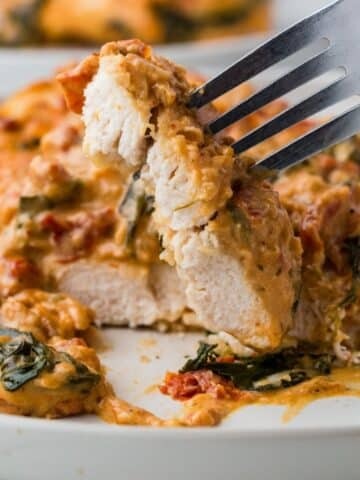 Healthy Marry Me Chicken
Healthy Marry Me Chicken Chicken and Broccoli with Cashews
Chicken and Broccoli with Cashews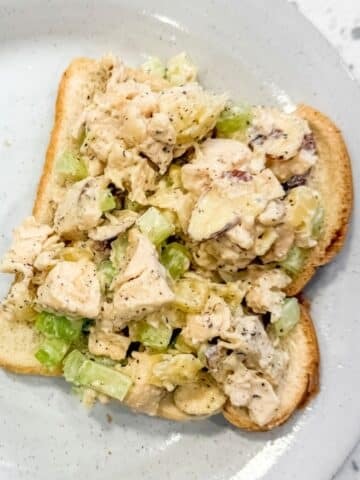 Hawaiian Chicken SaladPairing with Salads
Hawaiian Chicken SaladPairing with SaladsThese are my favorite dishes to serve with Spinach and Goat Cheese Chicken Breasts:
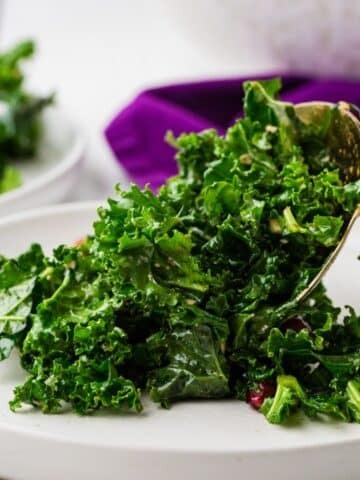 Kale and Pomegranate Salad
Kale and Pomegranate Salad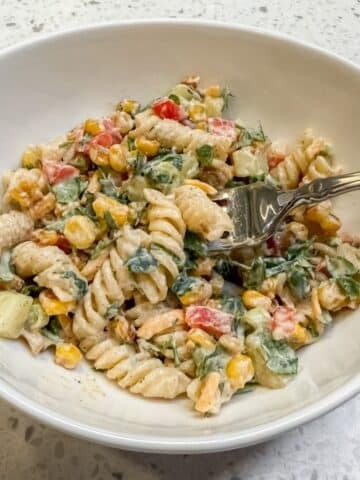 Corn Pasta Salad
Corn Pasta Salad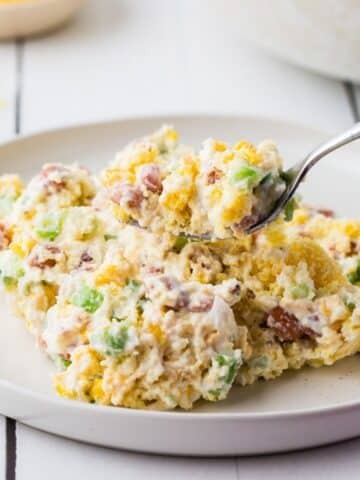 Cornbread Salad
Cornbread Salad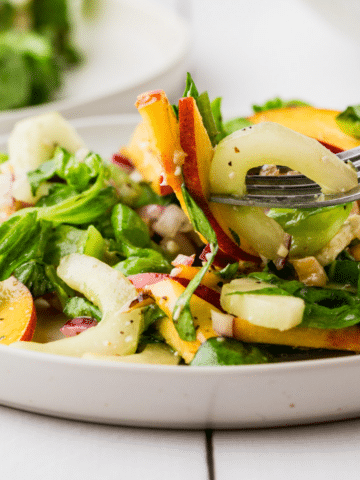 Nectarine Salad
Nectarine SaladIf you tried this Recipe or any other recipe on my website, please please leave a star rating and let me know how it goes in the comments below. I love hearing from you!
Recipe PrintSpinach and Goat Cheese Stuffed Chicken Breasts#wprm-recipe-user-rating-0 .wprm-rating-star.wprm-rating-star-full svg * { fill: #343434; }#wprm-recipe-user-rating-0 .wprm-rating-star.wprm-rating-star-33 svg * { fill: url(#wprm-recipe-user-rating-0-33); }#wprm-recipe-user-rating-0 .wprm-rating-star.wprm-rating-star-50 svg * { fill: url(#wprm-recipe-user-rating-0-50); }#wprm-recipe-user-rating-0 .wprm-rating-star.wprm-rating-star-66 svg * { fill: url(#wprm-recipe-user-rating-0-66); }linearGradient#wprm-recipe-user-rating-0-33 stop { stop-color: #343434; }linearGradient#wprm-recipe-user-rating-0-50 stop { stop-color: #343434; }linearGradient#wprm-recipe-user-rating-0-66 stop { stop-color: #343434; }#wprm-recipe-user-rating-0.wprm-user-rating-allowed.wprm-user-rating-not-voted:not(.wprm-user-rating-voting) svg * { fill-opacity: 0.3; }This recipe guides you through creating a flavorful chicken dish stuffed with goat cheese, bacon, and spinach, then cooked to perfection in a skillet and oven. Finish it off with a rich balsamic glaze for an impressive meal that's both simple and delicious.Course Entree, Main CourseCuisine American, ItalianDiet Diabetic, Low SaltPrep Time 15 minutes minutesCook Time 30 minutes minutesTotal Time 45 minutes minutesServings 2Calories 271kcalAuthor Mathea Ford, RDN, LD, MBAIngredients2 tablespoon OLIVE OIL salad or cooking6 oz CHICKEN BREAST BONELESS, RAW, broiler/fryer, meat only½ oz GOAT CHEESE SEMISOFT1 slice BACON BROILED, LESS SALT, pan-fried or roasted, cured2 tablespoon Fresh Spinach1 teaspoon PEPPER BLACK, GROUND½ cup VINEGAR BALSAMICGet ingredients with
PrintSpinach and Goat Cheese Stuffed Chicken Breasts#wprm-recipe-user-rating-0 .wprm-rating-star.wprm-rating-star-full svg * { fill: #343434; }#wprm-recipe-user-rating-0 .wprm-rating-star.wprm-rating-star-33 svg * { fill: url(#wprm-recipe-user-rating-0-33); }#wprm-recipe-user-rating-0 .wprm-rating-star.wprm-rating-star-50 svg * { fill: url(#wprm-recipe-user-rating-0-50); }#wprm-recipe-user-rating-0 .wprm-rating-star.wprm-rating-star-66 svg * { fill: url(#wprm-recipe-user-rating-0-66); }linearGradient#wprm-recipe-user-rating-0-33 stop { stop-color: #343434; }linearGradient#wprm-recipe-user-rating-0-50 stop { stop-color: #343434; }linearGradient#wprm-recipe-user-rating-0-66 stop { stop-color: #343434; }#wprm-recipe-user-rating-0.wprm-user-rating-allowed.wprm-user-rating-not-voted:not(.wprm-user-rating-voting) svg * { fill-opacity: 0.3; }This recipe guides you through creating a flavorful chicken dish stuffed with goat cheese, bacon, and spinach, then cooked to perfection in a skillet and oven. Finish it off with a rich balsamic glaze for an impressive meal that's both simple and delicious.Course Entree, Main CourseCuisine American, ItalianDiet Diabetic, Low SaltPrep Time 15 minutes minutesCook Time 30 minutes minutesTotal Time 45 minutes minutesServings 2Calories 271kcalAuthor Mathea Ford, RDN, LD, MBAIngredients2 tablespoon OLIVE OIL salad or cooking6 oz CHICKEN BREAST BONELESS, RAW, broiler/fryer, meat only½ oz GOAT CHEESE SEMISOFT1 slice BACON BROILED, LESS SALT, pan-fried or roasted, cured2 tablespoon Fresh Spinach1 teaspoon PEPPER BLACK, GROUND½ cup VINEGAR BALSAMICGet ingredients with  InstructionsPreheat oven to 375 degrees.Butterfly the chicken by running a sharp knife horizontally through the thickest part of each breast. Place one hand on top of the breast to stabilize while holding the knife parallel to the work surface while cutting. Do not cut all the way through. Open the breast so both halves can lie flat.Season the exposed surface with pepper, then add ½ of the goat cheese, crumbled bacon, and spinach leaves to each breast. Fold the breasts in half so the cheese mixture is surrounded by chicken breast on the bottom, back and top. Secure with long wooden toothpicks, if desired.Heat olive oil over medium-high heat in a large oven-safe skillet. Once hot, add the stuffed chicken breasts to the pan to sear. Once browned on the bottom, carefully turn each breast over and repeat on the other side. Season top and bottom with pepper, if desired, during this process.Place skillet in preheated oven and cook until an instant read thermometer reads 165 degrees Fahrenheit when inserted, approximately 25-30 minutes. Remove from the oven and cover until ready to serve.A few minutes before removing the chicken from the oven, start making the balsamic glaze. Heat balsamic vinegar in a small sauce pan over medium-high heat. Stir while heating until the vinegar is reduced to about â
of its original volume. It will form a thick, syrupy consistency when it is ready.To serve, place a stuffed chicken breast on each plate and drizzle with balsamic glaze.VideoNutritionCalories: 271kcal | Carbohydrates: 12g | Protein: 20g | Fat: 18g | Saturated Fat: 3g | Polyunsaturated Fat: 2g | Monounsaturated Fat: 11g | Trans Fat: 0.01g | Cholesterol: 58mg | Sodium: 162mg | Potassium: 450mg | Fiber: 1g | Sugar: 10g | Vitamin A: 1491IU | Vitamin C: 5mg | Vitamin D: 0.1µg | Calcium: 51mg | Iron: 1mg | Phosphorus: 212mgCheck Out Our Meal Plans For People With Chronic Kidney Disease (CKD)
InstructionsPreheat oven to 375 degrees.Butterfly the chicken by running a sharp knife horizontally through the thickest part of each breast. Place one hand on top of the breast to stabilize while holding the knife parallel to the work surface while cutting. Do not cut all the way through. Open the breast so both halves can lie flat.Season the exposed surface with pepper, then add ½ of the goat cheese, crumbled bacon, and spinach leaves to each breast. Fold the breasts in half so the cheese mixture is surrounded by chicken breast on the bottom, back and top. Secure with long wooden toothpicks, if desired.Heat olive oil over medium-high heat in a large oven-safe skillet. Once hot, add the stuffed chicken breasts to the pan to sear. Once browned on the bottom, carefully turn each breast over and repeat on the other side. Season top and bottom with pepper, if desired, during this process.Place skillet in preheated oven and cook until an instant read thermometer reads 165 degrees Fahrenheit when inserted, approximately 25-30 minutes. Remove from the oven and cover until ready to serve.A few minutes before removing the chicken from the oven, start making the balsamic glaze. Heat balsamic vinegar in a small sauce pan over medium-high heat. Stir while heating until the vinegar is reduced to about â
of its original volume. It will form a thick, syrupy consistency when it is ready.To serve, place a stuffed chicken breast on each plate and drizzle with balsamic glaze.VideoNutritionCalories: 271kcal | Carbohydrates: 12g | Protein: 20g | Fat: 18g | Saturated Fat: 3g | Polyunsaturated Fat: 2g | Monounsaturated Fat: 11g | Trans Fat: 0.01g | Cholesterol: 58mg | Sodium: 162mg | Potassium: 450mg | Fiber: 1g | Sugar: 10g | Vitamin A: 1491IU | Vitamin C: 5mg | Vitamin D: 0.1µg | Calcium: 51mg | Iron: 1mg | Phosphorus: 212mgCheck Out Our Meal Plans For People With Chronic Kidney Disease (CKD)The post Spinach and Goat Cheese Chicken Breasts appeared first on Renal Diet HQ.
March 7, 2025
Kidney Disease and Fast Food: Safe Options You Can Enjoy-Podcast

Living with chronic kidney disease (CKD) doesnât mean you have to give up on enjoying a quick and tasty meal. While fast food often gets a bad reputation for its high sodium, fat, and preservative content, there are still ways to make informed choices that align with a kidney-friendly diet. By paying attention to sodium, protein, phosphorus, and potassium levels, you can find options that fit your dietary needs.
For More Recipes and Ideas --->> Get Your Free Meals and Recipes That Are Perfect for Pre-Dialysis Diets, Pre-Dialysis with Diabetes, or Dialysis Diets.
Understanding Nutritional Concerns for CKDPeople with CKD need to be especially mindful of their diet to help manage kidney function. Hereâs why certain nutrients matter:
Sodium: High sodium intake can raise blood pressure and cause fluid retention, making it harder for your kidneys to function properly.Protein: Too much protein can put extra strain on the kidneys, so portion control is important.Phosphorus: Processed foods and fast food often contain phosphate additives, which can build up in the blood when kidney function declines.Potassium: Some foods, like tomatoes and potatoes, are naturally high in potassium, which CKD patients may need to limit.While fast food is often high in these nutrients, making smart choices can help reduce the risks.
Kidney-Friendly Fast Food ChoicesIf youâre craving fast food, here are some better options to consider:
Lower-Sodium Options: Choose grilled chicken sandwiches, plain hamburgers without cheese, or a side salad with dressing on the side.Protein Considerations: Opt for smaller portion sizes or plant-based proteins like a veggie burger (if low in potassium and phosphorus).Managing Phosphorus and Potassium: Avoid processed meats, cheese, and condiments high in phosphorus. Choose fresh ingredients where possible.Customizing Your Fast Food OrderTo make fast food more kidney-friendly, try these modifications:
Ask for no added salt on fries or burgers.Skip sauces and dressings that are high in sodium and phosphorus.Choose water or unsweetened beverages instead of soda.Swap fries for a side salad or fruit when available.Practical Tips for Eating Fast Food with CKDCheck the restaurantâs nutrition information online before ordering.Stick to smaller portions to keep sodium and protein intake in check.Balance fast food meals with home-cooked, kidney-friendly meals during the rest of the day.Plan ahead so you can make healthier choices without feeling rushed.Eating fast food with CKD requires careful planning, but it doesnât have to be off-limits. By choosing lower-sodium options, managing portion sizes, and customizing your order, you can enjoy the convenience of fast food while staying within your dietary needs. Always consult your dietitian for personalized advice on making kidney-friendly choices.
Learn more about Can I still eat bananas if I have CKD?-Podcast
The post Kidney Disease and Fast Food: Safe Options You Can Enjoy-Podcast appeared first on Renal Diet HQ.
March 5, 2025
Can I still eat bananas if I have CKD?-Podcast

Bananas are a popular and nutritious fruit, but if you have Chronic Kidney Disease (CKD), you might be wondering if theyâre safe to eat. Since CKD often requires monitoring potassium intake, itâs important to understand how bananas fit into a kidney-friendly diet. In this post, weâll break down the potassium content in bananas, their impact on CKD, and practical tips for managing potassium intake.
For More Recipes and Ideas --->> Get Your Free Meals and Recipes That Are Perfect for Pre-Dialysis Diets, Pre-Dialysis with Diabetes, or Dialysis Diets.
The Potassium Content in BananasBananas are well known for being high in potassium, a vital mineral that helps regulate heart function, muscle contractions, and nerve signals. However, for individuals with CKD, the kidneys may struggle to remove excess potassium from the blood. This can lead to hyperkalemia, a condition where potassium levels become dangerously high, increasing the risk of heart complications.
Are Bananas Safe for CKD Patients?Many CKD patients worry about whether they can include bananas in their diet. The answer depends on the severity of kidney disease and individual potassium needs. In early-stage CKD, some people can still consume small amounts of potassium-rich foods like bananas. However, those with advanced CKD or on dialysis may need to avoid or strictly limit high-potassium foods to prevent health risks.
Alternative Low-Potassium FruitsIf you need to reduce potassium intake but still want to enjoy fruit, consider these kidney-friendly alternatives:
ApplesBerries (strawberries, blueberries, raspberries)GrapesPineapplePeaches These fruits provide essential vitamins and antioxidants without excessive potassium, making them safer choices for CKD patients.Managing Potassium Intake While Eating BananasIf your healthcare provider allows you to eat bananas, here are some ways to manage your potassium intake:
Portion Control: Stick to a small banana or half a banana instead of a whole one.Pairing: Eat bananas with lower-potassium foods to balance overall intake.Frequency: Limit how often you eat bananas and track potassium intake from other sources.Cooking Methods: Some cooking methods, like boiling, can reduce potassium content in certain foods, though this is not common with bananas.Bananas are high in potassium, which means CKD patients must be mindful of their intake. Depending on the stage of kidney disease, some people may be able to enjoy bananas in moderation, while others may need to opt for lower-potassium alternatives. Always consult with your healthcare provider or dietitian to determine whatâs best for your kidney health. By making informed choices, you can enjoy a delicious and balanced diet while managing CKD effectively.
Learn more about The Importance Of Diet For Stage 3 Chronic Kidney Disease-Podcast
The post Can I still eat bananas if I have CKD?-Podcast appeared first on Renal Diet HQ.
February 28, 2025
Marching Towards Spring Meal
Marching Towards Spring with a Kidney-Friendly Feast! As the seasons shift and fresh flavors emerge, enjoy a nourishing, kidney-friendly meal that brings warmth and vibrancy to your table. This balanced menu is thoughtfully crafted for those managing Chronic Kidney Disease (CKD), offering a delightful mix of flavors and textures without compromising on health.
Start with Greek Turkey Meatballs with Tzatziki Sauce, a protein-packed dish bursting with Mediterranean herbs and a creamy, refreshing dip. Pair it with Garlic Turmeric Rice, a fragrant, golden-hued side thatâs both comforting and kidney-conscious. Add a touch of color with Corn and Green Beans, a simple yet flavorful vegetable medley that enhances the meal with natural sweetness and freshness. Finally, satisfy your sweet tooth with Tangerine Cake, a light, citrus-infused dessert that perfectly rounds out this wholesome spring-inspired feast.
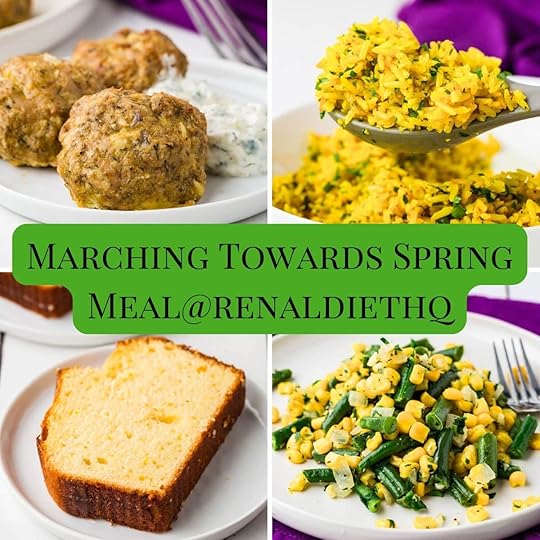 Get A Copy Of Marching Towards Spring Meal for CKD In Your InboxKidney Friendly Spring Vegetable Recipes
Get A Copy Of Marching Towards Spring Meal for CKD In Your InboxKidney Friendly Spring Vegetable RecipesMarch Into Spring with a Kidney-Friendly Feast! Welcome the new season with a fresh, flavorful meal designed for those managing Chronic Kidney Disease (CKD). This balanced menu is low in sodium and potassium while celebrating the vibrant tastes of spring, making it both nourishing and delicious.
As a Registered Dietitian Nutritionist specializing in Chronic Kidney Disease (CKD) and the owner of RenalDietHQ.com, Iâm committed to helping individuals take control of their kidney health through practical, evidence-based nutrition strategies. With extensive experience in crafting kidney-friendly meal plans and resources, I focus on guiding those with CKD to enjoy flavorful, balanced meals that support their health and well-being. Every recipe and dietary recommendation I share is carefully designed to meet the unique needs of those managing CKD, helping them lead a healthier and more fulfilling lifestyle.
Greek Turkey Meatballs This recipe is a flavorful, kidney-friendly meal made with lean turkey, aromatic herbs, and a touch of feta cheese. Served with refreshing tzatziki sauce, itâs simple to prepare and perfect for those managing kidney disease. Nutritious, delicious, and easy to make, itâs a great option for anyone looking for a balanced, kidney-safe meal.
Garlic Turmeric Rice is a vibrant, kidney-friendly dish perfect for those managing CKD. Made with simple ingredients like turmeric and garlic, it offers rich flavor while adhering to kidney care guidelines. Nutritious, aromatic, and easy to prepare, itâs a comforting and healthy addition to any meal.
Green Beans and Corn recipe is a simple, flavorful side dish ideal for those with kidney disease. Made with easy ingredients like frozen corn, green beans, and fresh parsley, itâs quick to prepare and supports a kidney-conscious diet without sacrificing taste. Perfect for beginners, this dish is both nutritious and satisfying.
Tangerine Cake is a delicious, citrus-flavored dessert perfect for those with kidney disease. Simple to make with fresh, tangy ingredients, it offers a sweet treat that meets dietary needs without compromising on flavor. Ideal for novice bakers, itâs a guilt-free dessert option.
Celebrate the arrival of spring with a vibrant, kidney-friendly menu thatâs perfect for welcoming the season. This fresh and flavorful spread is designed to nourish your body and delight your taste buds, making it an ideal choice for anyone looking to enjoy a health-conscious meal as we march into spring.
Check Out Our Meal Plans For People With Chronic Kidney Disease (CKD)Recent Kidney Friendly RecipesGreek Turkey Meatballs
Garlic Turmeric Rice
Green Beans and Corn
Tangerine Cake
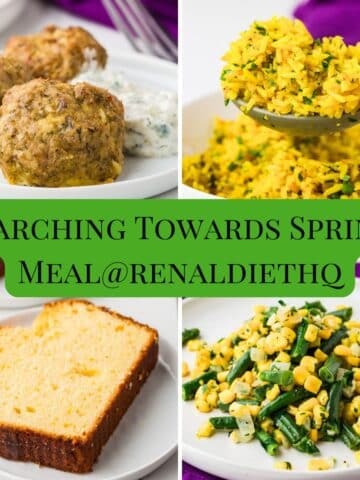 Marching Towards Spring Meal
Marching Towards Spring Meal Tangerine Cake
Tangerine Cake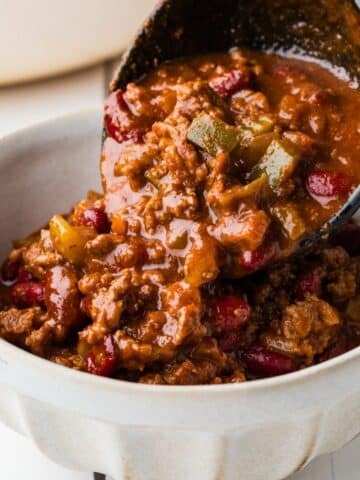 Simple Low Sodium Chili
Simple Low Sodium Chili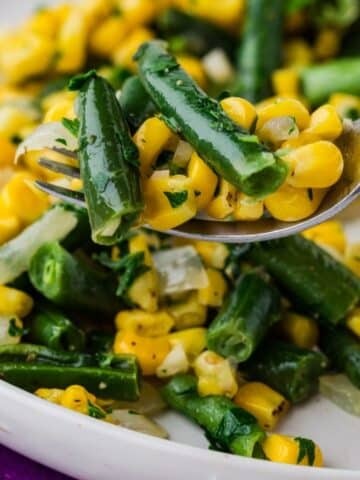 Green Beans and Corn
Green Beans and CornThe post Marching Towards Spring Meal appeared first on Renal Diet HQ.



